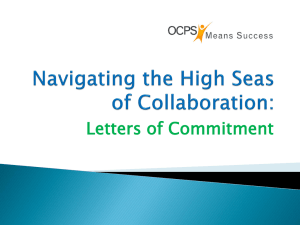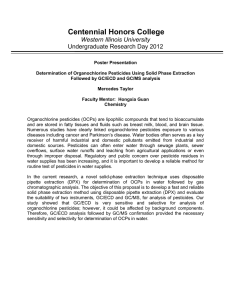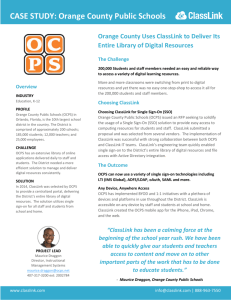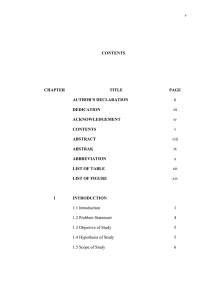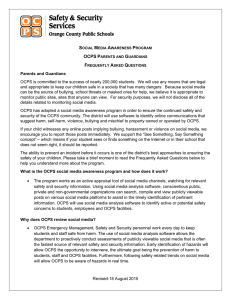CHAPTER 1 INTRODUCTION 1.1
advertisement
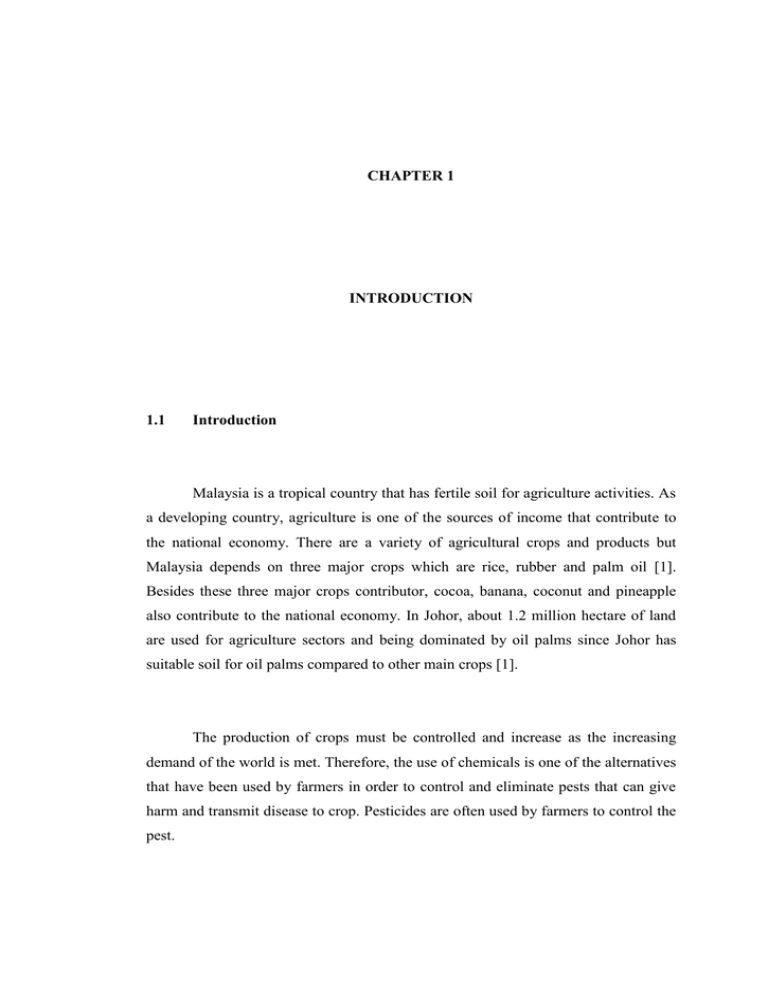
CHAPTER 1 INTRODUCTION 1.1 Introduction Malaysia is a tropical country that has fertile soil for agriculture activities. As a developing country, agriculture is one of the sources of income that contribute to the national economy. There are a variety of agricultural crops and products but Malaysia depends on three major crops which are rice, rubber and palm oil [1]. Besides these three major crops contributor, cocoa, banana, coconut and pineapple also contribute to the national economy. In Johor, about 1.2 million hectare of land are used for agriculture sectors and being dominated by oil palms since Johor has suitable soil for oil palms compared to other main crops [1]. The production of crops must be controlled and increase as the increasing demand of the world is met. Therefore, the use of chemicals is one of the alternatives that have been used by farmers in order to control and eliminate pests that can give harm and transmit disease to crop. Pesticides are often used by farmers to control the pest. 2 Pesticides are broadly defined by the United States’ Federal Insecticide, Fungicide, and Rodenticide Act (FIFRA) as a substance or mixture intended to prevent, destroy, repel, or mitigate any pest including insects, rodents, and weeds [2]. They include not only insecticides but also herbicides, fungicides, disinfectants, and growth regulators. Pesticides have been used in some crude form since early times, but the modern use of synthetic pesticides began in the early to mid twentieth century. Currently, there is a catalogue of over 800 pesticides formulated in 21 000 different products that are registered with the US Environmental Protection Agency (EPA) for use in the United States [2]. River is the alley of transportation and communication which is very important especially during the Neolithic time in Malaysia. It continues to be a very important source of food for societies around the world. Apart from being a rich source of fish, rivers indirectly aid in cultivation with its supply of water for the crops. In the transport process, marine and lake play an important role as a sink of pollutants. Rain also influences the transport and precipitation process. In Johor, many of the rivers have become polluted due to wastes that have flowed into the rivers. There are many sources that contribute to the water pollution such as sewage from treatment plants, manufacturing, agro-based industries and also animal farms [3]. As a main source of water, pollution sources from various activities into the river must be identified to maintain the water quality. Therefore, monitoring of water quality should be done seriously to save the river for our next generation. Water filtration techniques are widely applied in environmental analytical chemistry in order to study the partitioning of contaminants between the particulate and dissolved phases and better understand their transport, bioavailability and fate in the environment. Water passing through a filter (filtrate) contains compounds that are truly dissolved and compounds that are bound to the operationally defined “dissolved” organic matter (DOM) [4]. DOM, generally quantified as “dissolved” organic carbon (DOC), includes both organic matter that is truly dissolved in the 3 aqueous phase and colloidal organic matter [5]. The degree of interaction between the chemicals and the DOM is closely related to the molecular size, conformation and composition of the DOM, but is also affected by the intrinsic physicochemical properties of the compounds themselves [5]. This study focused on the adsorption of pesticides on cellulose fiber filters after filtration of water samples. The contaminants were focused on the chlorinated pesticides that has lower solubility towards water covering a broad range of physicochemical properties (solubility range: 0.005 to 8.0 mg/L) (Table 1) [5]. The sample were extracted using ultrasonic technique before analyzed using gas chromatography with mass selective detector (GC-MSD) and gas chromatography electron capture detector (GC-ECD) for quantitative study and qualitative study by using liquid chromatography and gas chromatography with mass spectrometry. Table 1.1: Physiochemical properties of the selected pesticides [5] Contaminant Log Kow Solubility (mg L-1) (25 ˚C) ɣ-HCH 3.72 8.000 α-HCH 3.80 1.000 α-Endosulfan 3.83 0.500 Meyhoxychlor 5.08 0.045 Aldrin 6.50 0.027 Endrin 5.06 0.230 Dieldrin 5.40 0.170 HCB 5.73 0.005 Heptachlor-endo-epoxide 4.56 0.200 P,p’-DDD 6.02 0.050 P,p’-DDE 6.51 0.040 P,p’-DDT 6.91 0.005 4 1.2 Problem Statement Organochlorine pesticides (OCPs) have been widely used in the past by agriculture and industry and have led to widespread contamination throughout the environment. Strong lipophilic properties and long half-life time have caused the OCPs persistence in the environment and caused extensive concerns in the community. Despite the fact that the uses of OCPs in Malaysia have been banned, these compounds are still being detected in the environment worldwide due to their persistency [6]. This remains a concern, and therefore monitoring of OCPs in the river systems must be done in order to safeguard our water sources. Rivers in Malaysia generally appear to have high organic pollution loads and high suspended solid concentrations. OCPs has strong lipophilic properties and preferable to be adsorbed on the suspended solid. The monitoring of total suspended solids in river water as an indicator of river pollution due to sediment are done by the Department of Environment but there are no data about pesticide on suspended solid in our river water system. Due to these concerns, the monitoring of OCPs in suspended solid must be done in order to get a precise picture of the severity of river pollution in Malaysia. Several highly sensitive and selective analytical procedures to determine the levels of pesticide residues in a variety of matrices have been published [7, 8]. However, only very little information is available on extraction of pesticides in suspended solid by using ultrasonic solvent extraction (USE) has been reported in developing countries such as Malaysia. USE technique were used in this study due to its several advantages which is it consume less extraction time and solvent used, thus it is preferable for routine environmental analysis. Therefore, the aims of this study are to investigate several parameters that affect the extraction by USE technique in order to obtain higher recovery of the pesticide. 5 1.3 Objective of Study The objectives of this study are to: i. Qualitatively determine the presence of organochlorine pesticide (OCPs) which are aldrin, dieldrin and endrin in suspended solid after filtration of the river water samples by gas chromatography with mass selective detector (GC-MSD) and liquid chromatography with mass spectrometry (LC-MS/MS). ii. Optimization of extraction of aldrin, dieldrin and endrin in suspended solid using USE. iii. Application of USE technique at the optimum condition in extracting OCPs in suspended solid in river water of Sungai Skudai. 1.4 Hypothesis of Study Application of pesticide in agriculture can affect the environment when runoff and leaching process occur. High concentration of pesticide can be found at the area near to agriculture activities. OCPs have an aliphatic or aromatic cyclical structure, which is heavily substituted with chlorines. As a result, most OCPs are sparingly soluble and semi-volatile. Since OCPs have low solubility in water, they tend to adsorb strongly on suspended solid and sediments in the river water system. Thus, monitoring of OCPs in the suspended solid will give an indication of the level of river water pollution. 6 1.5 Scope of Study This study is divided into three areas which are sampling, extraction technique and analysis. Sampling had been carried out at Sungai Skudai using grab sampling technique. All water samples were stored in amber glass bottles to avoid contamination and degradation of analytes of interest. The extraction steps involve filtration of water sample using 0.45 µm cellulose membrane. OCPs with low solubility in water will adsorb on suspended solid that has been filtered through cellulose membrane. Ultrasonic technique was used to extract the OCPs from cellulose membrane by using different polarities of solvents and time of extraction. For qualitative study of the presence OCPs in suspended solid, GC-MSD and LC-MS-MS were used while for quantitative study the GC-ECD was used.
